Google Nexus 5 Review
by Brian Klug on December 5, 2013 8:00 AM EST- Posted in
- Smartphones
- LG
- Android
- Mobile
- Snapdragon 800
- Android 4.4
- Nexus 5
Display on mobile devices is one area where we’ve seen considerable improvement. Pixel density has gone up, contrast ratios have improved, and the emphasis on low power in a platform gated by its battery size means there’s always innovation happening.
In the case of the Nexus 5, there’s a considerable jump in resolution, from the WXGA 1280x768 display on the Nexus 4, to the now-standard 1080p. The biggest change is an obvious shift in aspect ratio from 15:9 to 16:9 once more. Back with the Nexus 4 and Optimus G, I noted just how surprisingly noticeable that extra 48 pixels of width was. Although we tend to think in absolute display resolution and talk about it quite a bit, Android uses display independent pixels or dips in order to keep layouts display density agnostic and support a wide variety of screen sizes and resolutions. Nexus 5 implements the 480 ppi or xxhdpi screen density, whereas Nexus 4 implements 320 ppi or xhdpi density. The result is that the Nexus 5’s display is 360x592 dips in size, compared to 384x592 dips for the Nexus 4, coming in 24 dips narrower. It’s important to note however that this change is intentional to maintain Android’s DPI independence, even if it does mean less overall real-estate in apps and browser.
Display quality is a big deal in the Android space, with lots of variance between devices. In the case of the Nexus 5, I started by tracking down the display type. If you recall, 5-inches with 1080p is a resolution we’ve seen before in the Droid DNA and Butterfly. From what I can tell, the Nexus 5 uses a very similar evolved version of that panel, a JDI (Japan Display, Inc) 1080p display with in-cell touch courtesy Synaptics ClearPad 3350 solution.
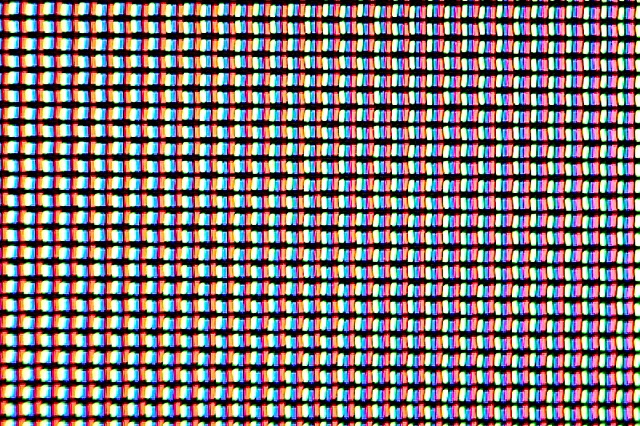
The other question was whether Nexus 5 also uses a PSR (Panel Self Refresh) type display. This display is indeed a MIPI command mode panel, the same kind of system, so yes it does include those features. An additional change is the addition of software vsync in Android 4.4, which to my knowledge the Nexus 5 does use, you can see this pop on and off depending on what’s happening on-screen if you monitor surfaceflinger. Those improvements should decrease latency and improve how sticky animations feel.
To characterize display quality and accuracy, we turn to our usual display measurements.
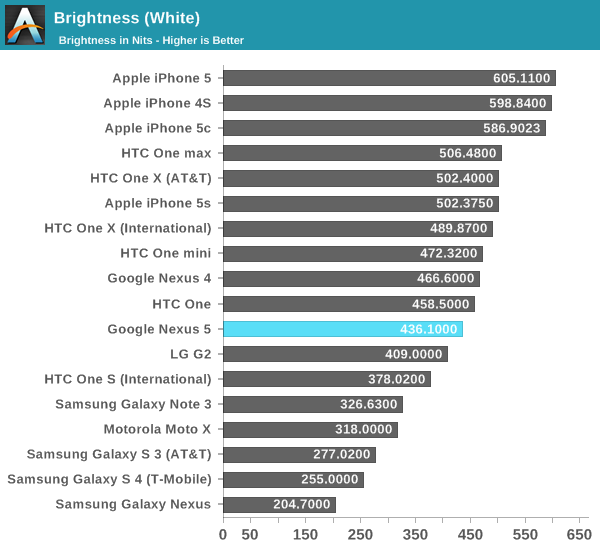
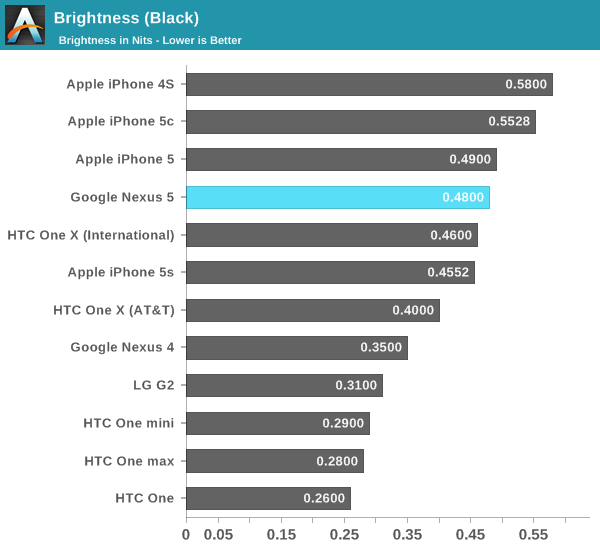
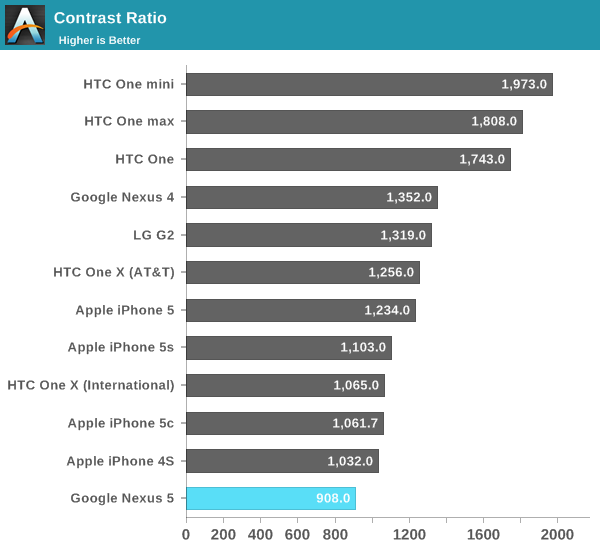
The Nexus 5 doesn’t go quite as bright as Nexus 4, but it’s still a very bright display. Blacks and contrast are a bit disappointing though, contrast is definitely on the lower end, but not bad. I definitely haven’t been put off by them. I also haven’t noticed any of the distracting dynamic brightness behavior I have on other handsets, which is awesome.
My only criticism is that I wish Nexus 5 would allow its auto screen brightness algorithm to go dimmer when in dark scenarios. There’s still more dynamic range in the manual brightness setting bar than there is for the auto brightness routine from what I can tell.

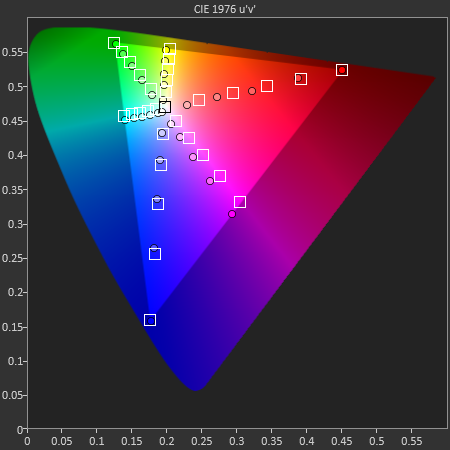
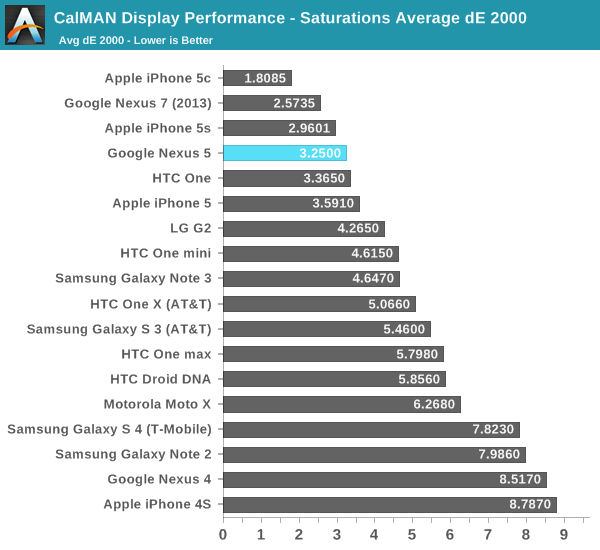
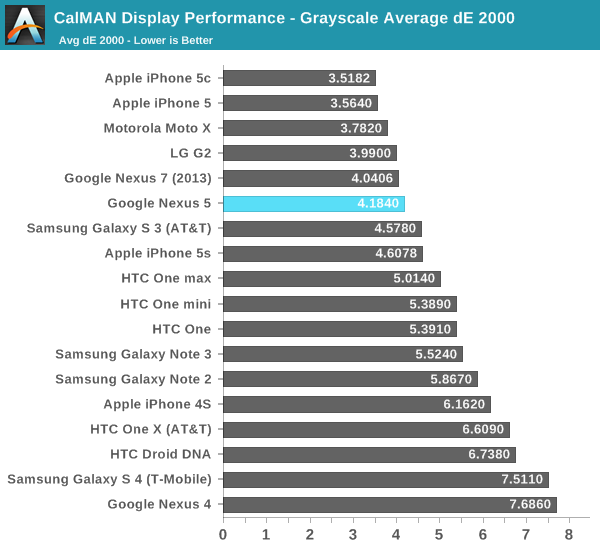
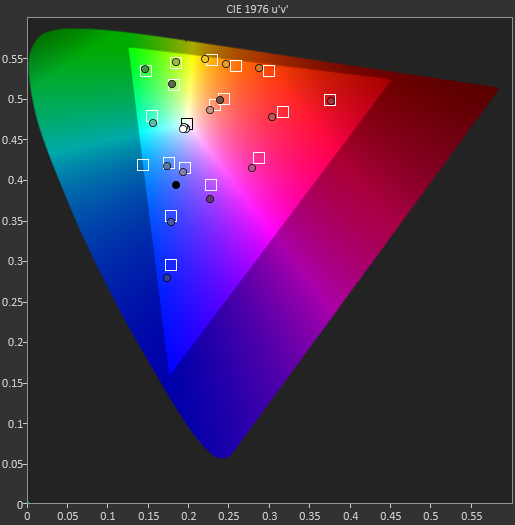
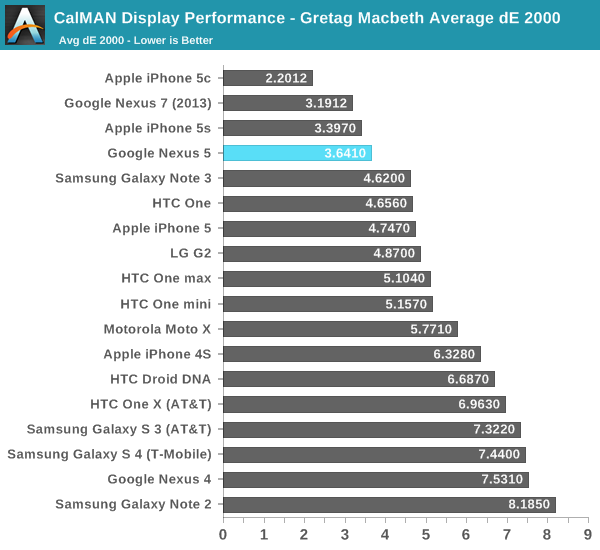
The new Nexus 7 impressed me with how accurate its display was in terms of color reproduction, beginning with Google stating it targeted sRGB (the color space for both the web and Android) calibration for it. The Nexus 5 seems to have done the same, and wowed me with the best GMB color checker Delta-Es we’ve seen from any Android handset. In addition, the Nexus 5 has none of the saturation boost that’s sadly quite pervasive right now, instead giving the right evenly spaced saturation stepping on its color channels. The Nexus 7 has slightly lower Delta-E, but it’s clear to me that Google has made color calibration an emphasis on the Nexus line.
It’s interesting to hear some Nexus 5 users complain that the display seems undersaturated, since that kind of end user feedback reflects subjective comparison. It also suggests to me that a large percentage of the population doesn’t know what some colors or system elements actually should be. Even for me, looking at the green elements inside the Google Play store on the Note 3 in movie mode or Nexus 5 initially seemed slightly more muted than normal. The reality is that this is what they actually should look like. We’ve just become accustomed to their oversaturated appearance on virtually every other device.
This kind of expectation about what looks right and what doesn’t is rather telling for the state of display calibration in Android handsets, and how OEMs have used oversaturated colors to increase retail shelf appeal. Unfortunately the reality is that oversaturated colors do seem to win taste tests among shoppers, the same way that TVs in most big boxes do. We’ve been looking at them for so long that well calibrated displays like Nexus 5 initially do look noticeably different.
The end result is easy to sum up, however – Nexus 5 has the best calibrated display I’ve seen so far in any Android handset. It’s also leaps and bounds more accurate and controlled than its predecessor display in the Nexus 4.


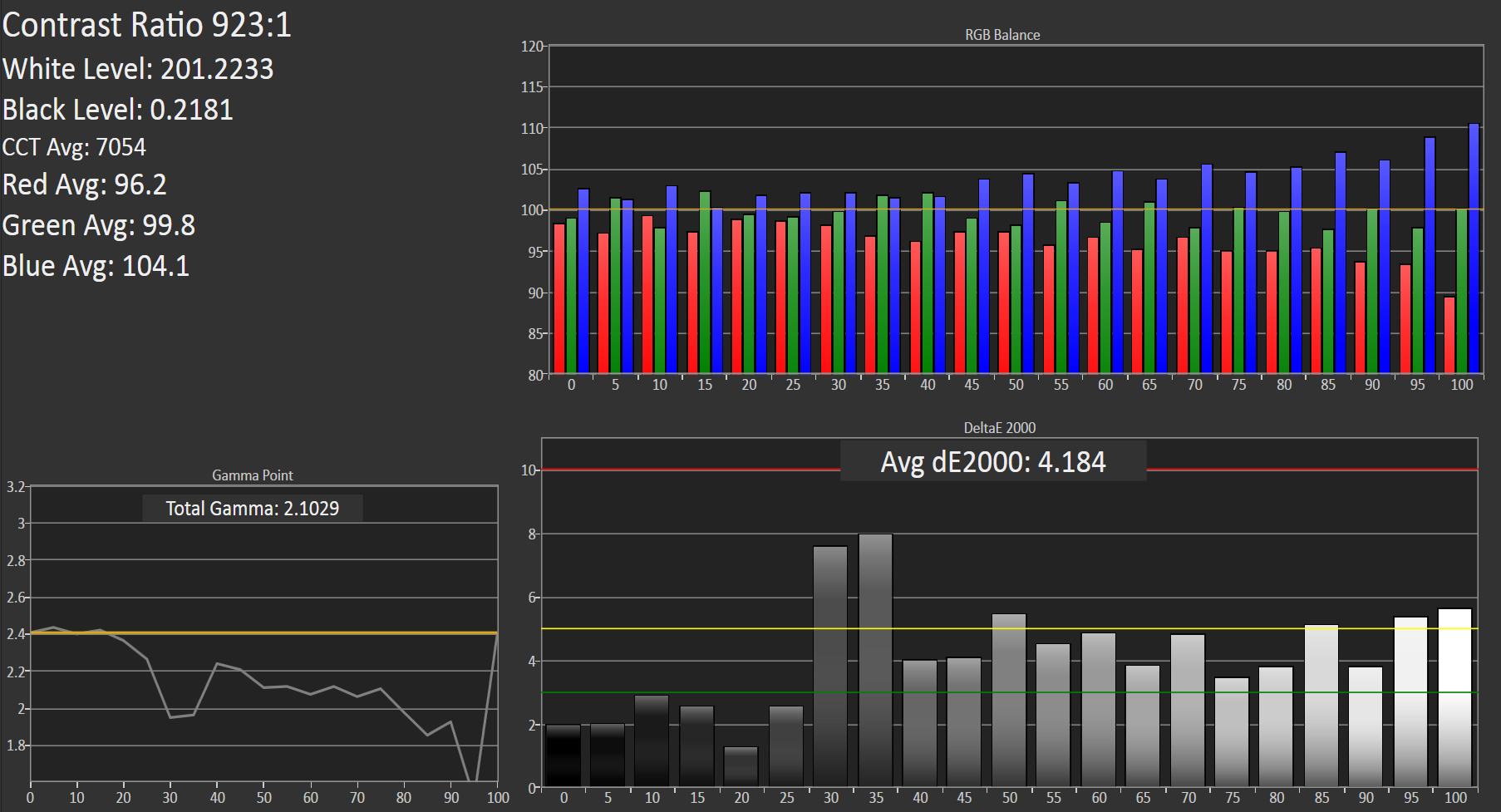








231 Comments
View All Comments
hamiltenor - Thursday, December 5, 2013 - link
Great review, I avoid The Verge like the plague lately. AnandTech, Ars Technica and to a lesser extent, Tom's Hardware are basically the only useful technology news sites from my point of view.Few typos, but I won't bother complaining. It's clear what you meant and they don't detract from the effort or lengths you went to for this review.
Looking forward to the line-out audio comparison!
cheinonen - Thursday, December 5, 2013 - link
I'm working on the article as fast as I can. I had to get another sample of a phone to verify something but I believe I have enough data to write it now. It's just big so it'll take a few days possibly. Lots of work to get done but it's coming ASAP.hrrmph - Thursday, December 5, 2013 - link
I will add to others comments that waiting for you guys to get it right is totally worth it. In spite of my nitpicks, Brian did great on this review, and I'm glad to hear that you are handling audio as a dedicated project.I am very interested to see what you find on your audio quality investigations, especially since 90% of my audio consumption is now via mobile devices with content as follows:
- 80% are WMA-LossLess rips from redbook CDs;
- 10% mp3-360kbs from Amazon; and
- 5% FLAC 24-bit from various sources (and growing on this one).
Having tried numerous devices, I will comment in advance that I find the BlackBerry Z10 to be great for commuting in a noisy environment (good oomph for cutting through rumble over the car speakers) and the Samsung Note 2 and Samsung S-ATIV seem well refined for quiet environment listening at my desks (home and work).
My point being that the sound "profiles" of these devices may not be perfectly accurate, but nonetheless both have their applications and usefulness.
96 and 192KHz / 24-Bit recordings are gradually making their way into my collection in increasing numbers and I'm really enjoying the sound. So HD-Audio is also an interest, especially for material that can make good use of the bandwidth.
WinPhone 8 generally cannot handle FLAC audio files, thus the Blackberry and Samsung Android are my go-to devices for music now. I use them with Sennheiser, Grado, or B&W cans over my head depending where I am at (home / work / travel).
I occasionally use a Gen 1 Asus Nexus 7 for audio listening - it is okay but clearly isn't as good as the Blackberry and Samsung devices, is on par with Zune, and much improved over the old Sansa devices. Hopefully they further improved the audio quality in the Gen 2 device, although I will skip it for other reasons.
The Z10 has excellent volume, while the Note 2 is too quiet in the car on some songs... thus indicating that some devices need supplementary amplification to reach satisfying volume on some songs. Hopefully sound volume issues will get addressed in future mobile devices.
Impulses - Friday, December 6, 2013 - link
Looking forward to this.Alpeshkh - Thursday, December 5, 2013 - link
Ah, should've curbed my excitement and read the display section fory that PSR thing!cgalyon - Thursday, December 5, 2013 - link
Could the camera performance be significantly improved with use of another camera app? I would be interested in seeing if you could do a comparison of the camera performance in the stock app, Camera Awesome, and VSCO Can. My thinking is that it could give us very valuable information on if the camera experience could in fact be one of the best on Android when provided with capable software. Thanks for the very detailed review!Tetracycloide - Thursday, December 5, 2013 - link
Most of the camera negatives are implemented before an app would be given camera data I think. Will require an OS update. 4.4.1 is supposed to be that OS update so we shouldn't have to wait long.AncientWisdom - Thursday, December 5, 2013 - link
Also VERY interested in this.... We know the problem, question is are third party camera apps the solution?blind2haters - Thursday, December 5, 2013 - link
Dude...the metal ring around the lens IS for magnetic lenses... It has already been tested and confirmed. Great research...not.Brian Klug - Thursday, December 5, 2013 - link
Nope. http://cl.ly/image/0o2a2d342R0oEntirely cosmetic at this point.
-Brian